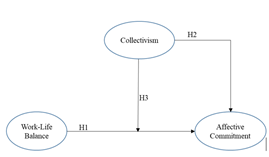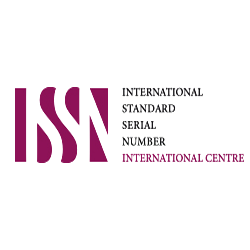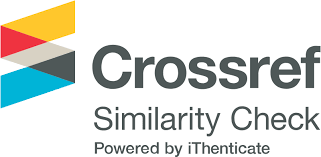
STEPS in BUSINESS EXCELLENCE (SBEXC)
Volume 1, Issue 1, pp: 1-8
![]()
Work-Life Balance and Affective Commitment:
The Moderating Role of Collectivism
Ahmed Zaid1,*
1,* Palestine Technical University-Kadoorie, Department of Logistic Management, Palestine
E-mail: a.zaid@ptuk.edu.ps
* Correspondence Author
Received: 20 June 2023 | Revised: 16 July 2023 | Accepted: 1 August 2023 | Published: 3 August 2023
The purpose of the current study is to examine the impact of work-life balance (WLB) for Small and Medium Enterprises (SME) employers and their employees’ affective commitment (AC), as well as the role of collectivism as a moderator between these constructs. A questionnaire was applied to collect data from 276 practitioners working in SMEs in Palestine. Partial least squares structural equation modelling (PLS-SEM) was used to analyze the data. The numerical results showed a substantial influence of WLB on AC and that collectivism also played a role as a moderator in the relationship between these constructs. Additionally, the study found that collectivism moderated the WLB – AC relationship. The implications of this research suggest that enhancing AC levels can promote workplace balance. This study contributes to an understudied association between WLB and AC in Palestinian SMEs, where the concept of collectivism is rarely utilized in relation to WLB and AC.
Keywords:
Work-life balance, Affective commitment, Collectivism, Small and medium enterprises, Palestine
Achieving work-life balance (WLB) has emerged as a significant challenge for both firms and employees in contemporary times (Sturges & Guest, 2004). As a result, numerous research studies in academia and practice have been dedicated to this topic. The advent of new technologies and evolving customer demands has revolutionized the traditional work patterns, making it difficult for individuals to maintain a proper work-life balance (Fayyazi & Aslani, 2015). The boundaries that once clearly separated work and personal life have now become blurred.
In essence, WLB refers to the contentment and effective functioning of individuals both at work and in their personal lives, with minimal conflict between the roles (Clark, 2000). Researchers widely acknowledge the significance of WLB, as it directly impacts an employee’s psychological well-being and overall sense of harmony in life. It serves as an indicator of how well the individual balances their responsibilities in the workplace and their roles within the family context (Kim, 2014). Based on the Herscovitch and Meyer (2002), affective commitment (AC) is a better predictor of behavioral support for a change than organizational commitment. Meyer and Herscovitch, (2001) define AC as an employee’s desire to promote an alteration based on their belief in the beneficial effects of the change. This emotional commitment is critical during organizational change because it acts as a coping resource.
Employees that have a strong emotional commitment to change are more likely to devote their resources in order to accomplish the intended outcomes of the change. As a consequence, they have become more prepared to deal with the challenges of severe organizational transitions and are less prone to suffer from emotional tiredness. The presence of this commitment helps to mitigate the perception of stress (Ning and Jing, 2012), leading to a sense of calmness among these employees (Javaid et al., 2021, 2022, 2023).
SMEs are of utmost importance to any economy, serving as a cornerstone for achieving equal welfare within a country (Alfoqahaa, 2018). In Palestine, SMEs hold a particularly significant role in driving socio-economic development by enhancing production capacity and addressing issues of poverty and unemployment (PCBS, 2018).
According to the Palestinian Central Bureau of Statistics (PCBS) census conducted in 2018, the West Bank and Gaza Strip together housed 142,400 private business entities, providing employment to 444,086 workers, which accounts for approximately 95 percent of the working organizations in Palestine (PCBS, 2018). Hence, SMEs play a pivotal role in driving equitable economic growth within the Palestinian economy. Tambunan (2007) emphasized that SMEs hold particular significance for developing countries, while Zhu et al. (2020) highlighted their potential as effective tools for poverty reduction, fostering innovation, and promoting sustainable development.
Finding the determinants of SMEs’ affective commitment (AC), collectivism, and work-life balance (WLB) are important and interesting research issues. Therefore, it becomes necessary to shed light on AC in SMEs to contribute resources and improve WLB in life. AC has been required worldwide to enhance the WLB for employers and enhance the competitive advantage of business organizations (Gulbahar et al., 2014). They further argued that changes in environments forced organizations to adopt AC among employees to formulate new strategies that enhance their internal efficiency and external effectiveness. This change pushed organizations to work hard to win and maintain their competitiveness by reducing costs, increasing profits, and making their operations more attractive. Long working hours, workload, high expected jobs, and the use of complicated technology have made it more difficult for employees to maintain balance in their lives between their work and other life commitments (Annink, 2017). Furthermore, the present discussions on work-life creativities’ diffusion and affective commitment about these practices should give further devotion to the significance of the business environment (Pasamar & Cabrera 2013). However, WLB, when reached and increased, is a vital problem of SMEs in the field of management and has received vital attention from researchers (Rani & Desiana, 2019).
In the current research, collectivism is playing a moderator role among variables because this research concentration on the association among WLB and AC in the context of Palestinian SMEs and aims to discover whether and how it differs from other cultures. Hypothetically, the consequence of collectivism on affective commitment is still underexplored (Hong et al., 2018) in the context of Palestinian SMEs. Van Hooft and De Jong (2009) emphasized that collectivism in the workplace can improve individual and group creativity and performance, but it remains unclear how collectivism can interact with WLB to affect AC.
Hence, the current research work is intended to answer the following two main research questions (RQ):
RQ1: How do work-life balance (WLB) of employees affect affective commitment (AC) in the Palestinian Small and Medium Enterprises (SME)?
RQ2: Does Collectivism moderate the relationship between WLB and AC in the Palestinian Small and Medium Enterprises (SME)?
To this end, this research intends to observe how WLB affects AC in SMEs. This study also explains the analysis of the concept of WLB in Palestinian SMEs. Furthermore, it presents the methodology, including the sample and population, and the clustering of results. Lastly, it provides final remarks, conclusions, directions for future research, and limitations.
2.1 Affective Commitment
The affective commitment (AC) has been observed as an industrial commitment and reveals a significant aspect of employee motivation for working at the workplace (Li et al., 2015). AC presents the influence level of employees and the contribution of an employee within an organization. The normative and continuance are also part of the commitment, but affective commitment is the element which is mostly used for organizational commitment (Saad et al., 2015). Previous research has established that it is possible to be very committed to a target with which you do not identify (Boxer and Rekettye, 2011). Recently, researchers have shown that out of the three dimensions of organizational commitment, the affective component is more desirable for the implication of the individual behavior of employees (Ribeiro et al., 2018).
Schoemmel and Jønsson (2014) studied the relationship between AC and quitting intention toward job performance. In their study, they investigated the interaction and usefulness of distinguishing between employees AC and quitting intention toward job performance. The finding of this research showed that the interaction between AC to the department and the organization concerning intentions is non-significant. The author also found that AC is strongly related to job performance.
In another study, Delić et al. (2017) also suggested that authentic leadership and AC are both very important predictors for the organization and have a significant role among them. Moreover, it seems that no previous study has examined the relationship between WLB and AC, especially in SMEs in Palestine. Several studies have postulated that AC has the highest rate compared to the two other commitments (Islam et al., 2015; Swalhi et al., 2017). Individuals who have a strong affective commitment will continue their work in SMEs. Therefore, this research focuses on AC because researchers assume that AC has a significant role in making a balance in the life of employees. Additionally, the research on AC has never been done in Palestinian SMEs, so it makes the researcher interested in studying the AC of workers in Palestinian SMEs.
2.2 Work-Life Balance
WLB represents the abilities of individual persons through gender and age, to associate with works and domestic successful responsibilities. According to Vasumathi and Prithi, (2018), the business uses quality of life as a strategic strategy to recruit and subsequently retain people, emphasizing the need of maintaining a work-life balance while maintaining an equal level of performance and dedication at work. In previous research, some studies have shown that WLB is linked significant impact on other variables such as job performance, gender, institutional pressure, and economic environment (Pasamar and Cabrera, 2013; McDonald et al., 2013). Vasumathi (2018), indicated that there was a positive association among management control, WLB, narrative and human competencies. Recently study by Soomro et al. (2018) postulated that WLB determines how much an employee of an organization can take time to balance their family and demand of works. Marques and Berry (2021) described that plans of working long hours cannot create flexible results in WLB. Consequently, these plans to increase the working hours can create flexibility in up and down issues for the families and extending for higher risks of error in human life.
Moreover, the dominant condition regarding WLB postulates a significant problem for the youngest work forces in SMEs. The imbalance among work and personal life can lead to decreased energy levels, reduced performance, and a lower quality of life.
In the national context, WLB issues are particularly sensitive (Goyal and Arora, 2012), meaning that the work environment could also affect the employees’ AC through WLB. Additionally, the WLB strategy aims to find a balance between paid work and non-work-related responsibilities by adjusting employee schedules at the workplace.
Past empirical studies indicate that individuals with high AC to change are more receptive to accepting organizational changes and are less likely to engage in withdrawal behaviour (Iverson & Buttigieg, 1999). However, there is still a research gap regarding the impact of affective commitment to change on an individual’s work-life balance. Existing research suggests that certain contexts, such as organizational changes that create feelings of uncertainty (e.g., job insecurity, role conflict) (Foster, 2010), as well as past negative experiences with change, are negatively related with AC (Rafferty & Restubog, 2010). Hence, we hypothesized that:
H1: WLB has a positive impact on AC in Palestinian SMEs.
2.3 Collectivism and affective commitment
Individualism and Collectivism are dimensions of culture that were first introduced by Hofstede (1980). Collectivism refers to several philosophical, political, spiritual, monetary, or societal perspectives that emphasize collective exchange with others. Individualism and collectivism can be categorized by different principles, values, worth, and norms that have implications for employee behavior and attitudes toward change (Hongyu et al., 2012). In a broad sense, collectivism refers to in-group harmony, personal relationships, and a focus on group goals and issues. Individualism, on the other hand, can be defined as autonomous, competitive behavior among employees with a goal to achieve at an individual level (Felfe et al., 2008). Furthermore, employees tend to develop close relationships when working collectively and appreciate the feeling of fitting into a social group (Hong et al., 2018).
The last two decades have seen rising attention on how cultural dimensions’ shape employees’ responses to their working environments (Kirkman et al., 2006). In a previous study, Hofstede’s (1980) cultural dimension of collectivism was used to examine the moderating effect on affective commitment. Although there has not been much research on the influence of WLB on AC, there is some empirical evidence at an individual level (Felfe et al., 2008). Previous studies have established that collectivism plays a significant role as a moderator among different relationships (Pian et al., 2019). For example, research by Hofman and Newman (2014) conducted in China found that collectivism is positively related to corporate social responsibility (CSR) and organizational commitment.
Another study by Yang et al. (2012) stated that collectivism moderates the effect of mediation on perceived workload between job dissatisfaction, turnover intention, and work hours. Wagner (1995) studied the mutual impact of individualism and collectivism on cooperation and found that collectivism moderates the positive effects of size, identifiability, and cooperation. Furthermore, as collectivism emphasizes fairness and kindness in the workplace, it may moderate the relationship between work-life balance and affective commitment. This study would help SMEs to understand the role of collectivism in strengthening affective commitment among employees in Palestine. It is proposed to investigate how collectivism as a moderator works between work-life balance and affective commitment in SMEs. However, this cultural dimension may particularly emphasize loyalty, and the value of collectivism is also respected as compared to less collectivist societies.
Based on the above discussion, the following hypotheses are developed:
H2: Collectivism has a positive impact on affective commitment (AC) in Palestinian SMEs.
H3: Collectivism will strengthen the relationship between work-life balance (WLB) and AC, such that the relationship will be stronger when collectivism is high in Palestinian SMEs.
The research framework of the current empirical study is presented in Figure 1, where the straight lines represent a direct association among WLB and AC, and collectivism shows the moderating link between the independent and dependent variables.

Figure 1. Research framework
The current study aims to measure the impact of WLB on AC, with collectivism used as a moderator. SMEs were considered in this research because previous studies assert that the availability of WLB is more homogeneous among SMEs (Cegarra-Leiva et al., 2012). The study employed a stratified random sampling technique to select a sample from the target population, which comprised employees of SMEs located in the West Bank region of Palestine, where a majority of industrial firms were situated. Primary data was collected through a survey, utilizing self-administered questionnaires as the main instrument. The survey participants were employees of SMEs, and the questionnaire design was straightforward and user-friendly. Initially developed in English, the questionnaires were later translated into Arabic, the local language. The survey was conducted between May and August 2021, and a total of 276 fully completed responses were received from the 330 respondents, yielding a response rate of 83.6%.
3.1 Measure
Table 1 shows the scales used to measure WLB, AC and collectivism. The WLB scale, consisted of five items adapted from Wong and Ko (2009), while the AC scale, consisted of three items adapted from Kim (2014). Finally, the collectivism construct consisted of five items adapted from Van Hooft and De Jong (2009). All variables were measured using a five-point Likert scale ranging from Strongly Disagree (1) to Strongly Agree (5).
Table 1. Construct and Measures
Construct | Items | Source |
AC | I hold a strong alignment with the values upheld by my organization. | Kim (2014). |
I have a deep sense of loyalty towards my organization. | ||
I take great pride in disclosing the name of my employer. | ||
Collectivism | I strive to maintain harmony and avoid disagreements with my group members. | Van Hooft and De Jong (2009) |
If a relative were facing financial difficulty, I would offer assistance to the best of my abilities. | ||
I prefer working on tasks within a group rather than working alone. | ||
Before making any decision, I always seek input from others and consult with them. | ||
To truly understand me, you need to observe how I interact with members of my group. | ||
WLB | Spending quality time with my family brings me happiness in my personal life. | Wong and Ko (2009) |
When discussing personal or family matters that may impact my work, my supervisor is empathetic and understanding. | ||
During specific stages of life, I am willing to forgo a higher position in exchange for personal and family well-being. | ||
Family support makes it effortless for me to concentrate at work. | ||
When I discuss personal or family matters that have an impact on my work, my co-workers are incredibly supportive. |
4.1. Respondent Demographic
The demographic information of the participants is presented in Table 2. The ages of the respondents were divided into three groups: 29.3% were between the ages of 18 and 24, 52.5% were between the ages of 25 and 35, and 18.2% were 36 or older. Gender distribution was also taken into account, with 56.1% of respondents being male and 34.9% female. The majority of responders (60.8%) were married, with the remaining 39.2% being single. Based on these data, it may be deduced that the majority of research participants were married and had children.
Table 2. Respondent Demographic Results
| Marital Status | Gender | ||
Age | Married | Single | Male | Female |
18-24 Years | 30 | 51 | 45 | 36 |
24-35 Years | 101 | 44 | 86 | 59 |
Above 35 Years | 37 | 13 | 24 | 26 |
4.2 Analysis
PLS-SEM was utilized to analyze the data, and prior to assessing the hypothesis, several checks, which included missing value and error tests, were performed to ensure that the data was suitable for analysis. In particular, PLS-SEM provides flexibility implications about the normality of variable distributions, which leads to more resilience when dealing with non-normal data (Henseler et al., 2009). Table 3 shows the mean and standard deviation for the research variables such as WLB, AC, and collectivism.
Table 3. Mean and Standard Deviation Results
No | Variable | Mean | Std. Dev. |
1 | Work-Life Balance (WLB) | 3.52 | 0.576 |
2 | Collectivism | 3.77 | 0.391 |
3 | Affective Commitment (AC) | 3.99 | 0.410 |
The respondents’ mean score on the AC scale was 3.89, with a standard deviation of 0.410, while the mean score of the WLB scale was 3.52, with a standard deviation of 0.576. The mean of collectivism was 3.77, with a standard deviation of 0.391. The WLB and collectivism scales showed acceptable reliability, with Cronbach’s alpha values of 0.720 and 0.856, respectively. The alpha reliability of the 3-item scale of affective commitment was found to be 0.766, which was also within an acceptable range. Pearson’s correlation was conducted to determine the association between WLB and AC, and the results showed a significant positive correlation (r=0.389, p<0.01), supporting hypothesis 1. Additionally, collectivism was significantly positively related to AC (r=0.214, p<0.01), supporting hypotheses 2 and 3. Table 4 presents the outcomes of Pearson’s correlation among constructs, and Table 5 shows the path coefficients with their respective t-value, p-values, R-square, and adjusted R-square. Two paths showed significant positive relationships among the constructs, with the highest positive significant path relationship between AC and WLB (β=0.249, t=2.871, p=0.001). This indicates that the effect of both exogenous constructs describes 32% of the variance in the endogenous construct. The bootstrapping method was used to determine the significance of the estimated path.
Table 4. Results of Correlation Coefficients
Variable | CR | Alpha | WLB | Collectivism | AC |
Work-Life Balance (WLB) | 0.83 | 0.720 | 1 |
|
|
Collectivism | 0.92 | 0.856 | 0.382* | 1 |
|
Affective Commitment (AC) | 0.88 | 0.766 | 0.388* | 0.214* | 1 |
Table 5. Results of Hypothesis Testing
Hypothesis | β | T-Value | P-Value | Result | R-Square | Adjusted R2 |
WLB→AC | 0.249 | 2.871 | 0.001 | supported | 0.320 | 0.467 |
Collectivism → AC | 0.199 | 3.225 | 0.004 | supported | ||
Moderation of Collectivism on WLB→AC | 0.105* | 3.998 | 0.000 | supported |
The research findings have vital associations for the development and implementation of WLB within SMEs in Palestine. The results indicate that WLB is influenced by AC to create a strong relationship among employees. It was found that WLB has a positive impact on AC, and that AC is strengthened by using collectivism as a moderator between WLB and AC. Employees’ belief in the future benefits of the change fosters a positive attitude towards the change (Iverson & Buttigieg, 1999). This positive attitude creates spill-over effects between their work and personal lives (Ferguson, 2012), leading to a positive impact on their work-life balance. These findings carry importance for managers to consider, as focusing on employees’ affective commitment to change could also influence their work-life balance. As previously mentioned, both AC and WLB have notable connections to individual and organizational performance, making them essential factors to take into account while managing organizational change. In fact, workers’ burnout and WLB serve as major predictors of job satisfaction (Rama Devi & Nagini, 2014).
SMEs management should observe and reduce the additional workload of employees to obtain maximum productivity and foster development in the workplace. If management fails to notice the burden of work on employees, employees may become less committed and exhibit negative behaviour, leading to a breakdown in commitment among them (Jum’a et al., 2023; Jum’a & Basheer, 2023). Therefore, SME executives must carefully plan to create a well-organized work environment and a well-structured work schedule to increase AC and employee collectivism.
Directors need to be proactive in interacting with employees and provide unique incentives for them to accomplish their job responsibilities. It is advised that specific programs be developed for employees who are less motivated and devoted than other institutional employees, such as seminars, formal meetings, and counselling sessions. Managers are also recommended initiate work redesign initiatives (Al-Alawneh et al., 2023; Alfares & Zaid, 2011). Furthermore, managers must recognize that the interaction among workers and their commitment to the organization may be influenced by a person’s cultural beliefs, which may increase both individual employees’ and the company’s creativity and productivity (Farh et al., 2004).
The study was conducted using empirical data from Palestine’s SMEs. The results demonstrated a direct association between WLB and employee AC. Moreover, the presence of collectivism was found to moderate this relationship positively, fostering encouraging behavior within SMEs. When employees have control over their work hours and exhibit strong commitment to management, it leads to favorable outcomes. The positive behavior and dedication of employees towards management play a vital role in enhancing SMEs’ performance and financial position. This research extends the scope of WLB strategies to enhance employee commitment and underscores the significance of collectivism in the workforce.
The study’s primary limitation stems from its cross-sectional data, which prevents from establishing any causal relationships. As a result, the generalizability of our findings may be somewhat restricted. For future research, we suggest conducting longitudinal studies to uncover the underlying relationships between the study variables. It would also be beneficial to focus on alternative industries like healthcare, higher education, or other service sectors. Additionally, introducing additional variables such as “job satisfaction” as a mediator could enrich the analysis. Moreover, researchers are encouraged to investigate the effects of individualism and organizational variables that have not been explored yet.
Cite: Zaid, A. (2023). Work-Life Balance and Affective Commitment: The Moderating Role of Collectivism. STEPS in BUSINESS EXCELLENCE, 1(1), 1–8. https://doi.org/10.61706/SBEXC12001
Copyright: © 2023 by the authors. Licensee SSG, Dubai, UAE.
This article is an open access article distributed under the terms and conditions of the Creative Commons Attribution (CC BY-NC-ND 4.0) license (http://creativecommons.org/licenses/by-nc-nd/4.0/).




An independent academic publisher with an editorial team including many of the top researchers in the world. SSG publishes research, review, and case report articles in double-blind, peer-reviewed, open access scientific and academic journals.
Copyright © 2023 Scientific Steps International Publishing Services LLC (Dubai – United Arab Emirates)